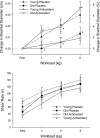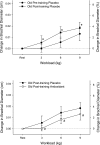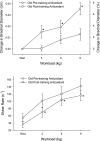Exercise-induced brachial artery vasodilation: effects of antioxidants and exercise training in elderly men
- PMID: 19966056
- PMCID: PMC2822587
- DOI: 10.1152/ajpheart.00761.2009
Exercise-induced brachial artery vasodilation: effects of antioxidants and exercise training in elderly men
Abstract
Aging, vascular function, and exercise are thought to have a common link in oxidative stress. Of the 28 subjects studied (young, 26 +/- 2 yr; old, 71 +/- 6 yr), 12 took part in a study to validate an antioxidant cocktail (AOC: vitamins C, E, and alpha-lipoic acid), while the remaining 8 young and 8 old subjects performed submaximal forearm handgrip exercise with placebo or AOC. Old subjects repeated forearm exercise with placebo or AOC following knee-extensor (KE) exercise training. Brachial arterial diameter and blood velocity (Doppler ultrasound) were measured at rest and during exercise. During handgrip exercise, brachial artery vasodilation in the old subjects was attenuated compared with that in young subjects following placebo (maximum = approximately 3.0 and approximately 6.0%, respectively). In contrast to the previously documented attenuation in exercise-induced brachial artery vasodilation in the young group with AOC, in the old subjects the AOC restored vasodilation (maximum = approximately 7.0%) to match the young. KE training also improved exercise-induced brachial artery vasodilation. However, in the trained state, AOC administration no longer augmented brachial artery vasodilation in the elderly, but rather attenuated it. These data reveal an age-related pro-/antioxidant imbalance that impacts vascular function and show that exercise training is capable of restoring equilibrium such that vascular function is improved and the AOC-mediated reduction in free radicals now negatively impacts brachial artery vasodilation, as seen in the young.
Figures




References
-
- Bailey DM, Ainslie PN, Jackson SK, Richardson RS, Ghatei M. Evidence against redox regulation of energy homoeostasis in humans at high altitude. Clin Sci (Lond) 107: 589–600, 2004 - PubMed
-
- Bailey DM, Davies B, Young IS, Jackson MJ, Davison GW, Isaacson R, Richardson RS. EPR spectroscopic detection of free radical outflow from an isolated muscle bed in exercising humans. J Appl Physiol 94: 1714–1718, 2003 - PubMed
-
- Bailey DM, Davies B, Young IS, Jackson MJ, Davison GW, Isaacson R, Richardson RS. EPR spectroscopic evidence of free radical outflow from an isolated muscle bed in exercising humans: functional significance of decreasing intracellular Po2 vs. increasing O2 flux. Adv Exp Med Biol 540: 297–303, 2003 - PubMed
-
- Bailey DM, Young IS, McEneny J, Lawrenson L, Kim J, Barden J, Richardson RS. Regulation of free radical outflow from an isolated muscle bed in exercising humans. Am J Physiol Heart Circ Physiol 287: H1689–H1699, 2004 - PubMed
-
- Beckman JS, Koppenol WH. Nitric oxide, superoxide, peroxynitrite: the good, the bad, ugly. Am J Physiol Cell Physiol 271: C1424–C1437, 1996 - PubMed
Publication types
MeSH terms
Substances
Grants and funding
LinkOut - more resources
Full Text Sources
Medical

